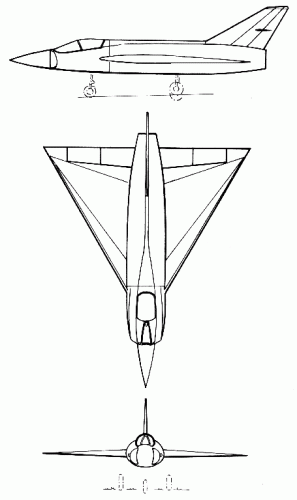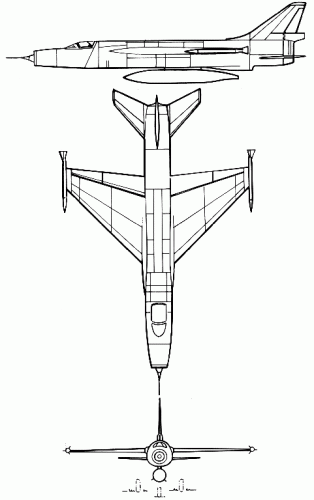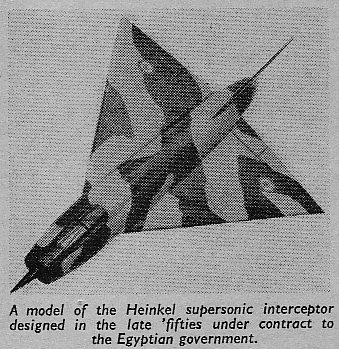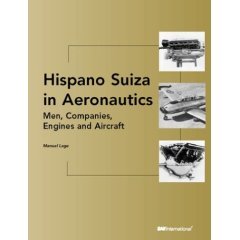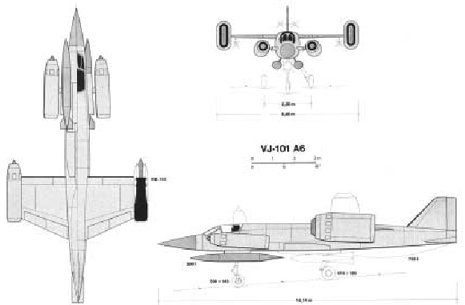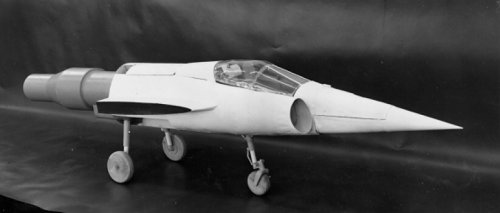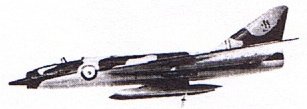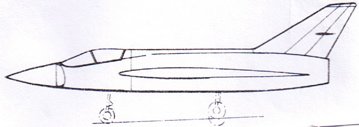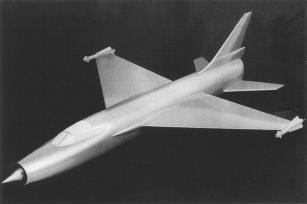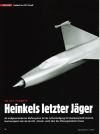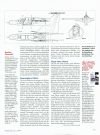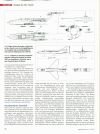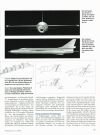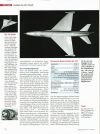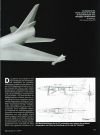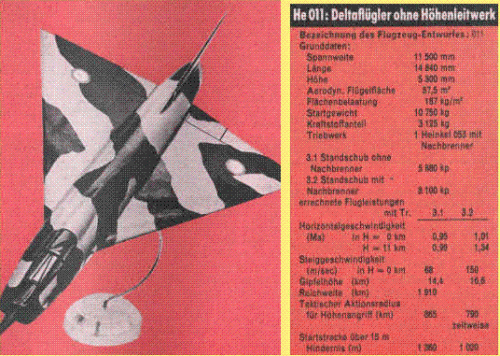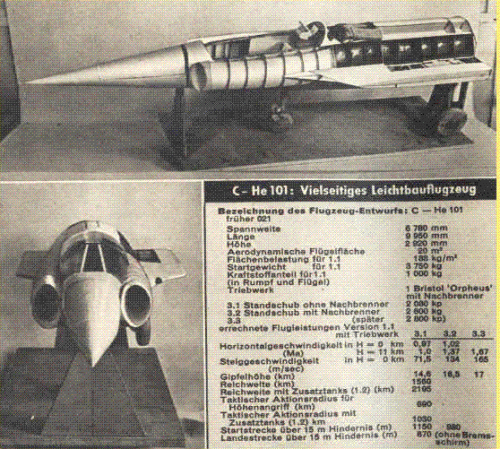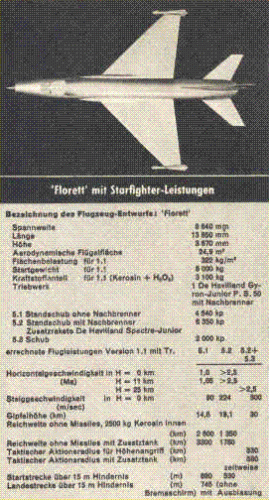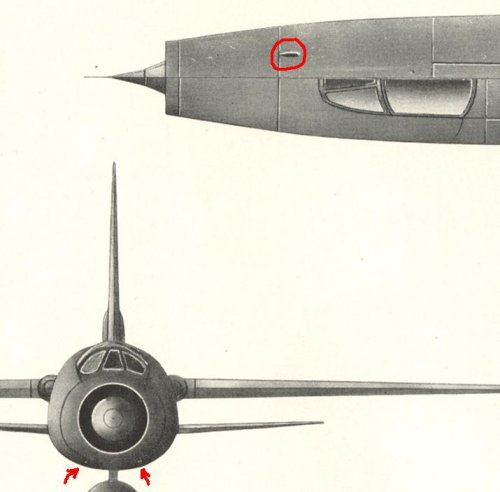You are using an out of date browser. It may not display this or other websites correctly.
You should upgrade or use an alternative browser.
You should upgrade or use an alternative browser.
Heinkel Postwar Fighters
- Thread starter richard
- Start date
richard
ACCESS: Top Secret
- Joined
- 1 May 2006
- Messages
- 578
- Reaction score
- 144
Hi , Jemiba 8
After the War during the 50' Siegfried Günter of the Ernst Heinkel AG , Stuttgart-Zuffenhausen, designed some delta jet fighters :
- He o11 (1954) single jet for Egypt
- He 011 twin jets
- He S 7
- He 021 (or 012 ? ) (1955) for Spain ( Casa CH 101 in Spain )
- He 031 Florett (1957)
For all of them my knowledge is very scarce ,whith some ???? ; I have pics of them apart the He 021
Who have more info ?
Thanks
Richard
After the War during the 50' Siegfried Günter of the Ernst Heinkel AG , Stuttgart-Zuffenhausen, designed some delta jet fighters :
- He o11 (1954) single jet for Egypt
- He 011 twin jets
- He S 7
- He 021 (or 012 ? ) (1955) for Spain ( Casa CH 101 in Spain )
- He 031 Florett (1957)
For all of them my knowledge is very scarce ,whith some ???? ; I have pics of them apart the He 021
Who have more info ?
Thanks
Richard
- Joined
- 12 July 2006
- Messages
- 948
- Reaction score
- 751
After the War during the 50' Siegfried Günter of the Ernst Heinkel AG , Stuttgart-Zuffenhausen, designed some delta jet fighters :
- He 011 (1954) single jet for Egypt
- He 011 twin jets
- He S 7
- He 021 (or 012 ? ) (1955) for Spain ( Casa CH 101 in Spain )
- He 031 Florett (1957)
For all of them my knowledge is very scarce ,whith some ? ; I have pics of them apart the He 021
Who have more info ?
The following three fighter-interceptors have been shortly described in Köhler’s “Ernst Heinkel – Pionier der Schnellflugzeuge” (“Die deutsche Luftfahrt“ vol 5), but the author causes confusion, speaking of a He 021 in the appendix and of a He 031 in the caption of the three-view drawing ...
He 011- projected for Egypt (it’s your turn, hesham)
- delta wing
- 1 x Heinkel He S 053 / 1 x 6,500 kp
- span 11.50 m
- length 14.75 m
- wing area 57.50 m²
- gross weight 12,000 kg
- speed Mach 1.2
- year 1956
- Antonio has sent me the attached model picture (from AIR Enthusiast or AIR International?) – the width of the nose and the position of the air intakes is different compared with the drawing.
He 012 (= C 101 -> for Spain –> Antonio, is there more about this project in Manuel Lage’s “Hispano Suiza 1904 - 1972: Hombres, Empresas, Motores y Aviones”?)
- delta wing
- 1 x Bristol Orpheus / 1 x 2,500 kp
- span 6.78 m
- length 9.95 m
- wing area 20.00 m²
- gross weight 3,900 kg
- speed Mach 1.2
- year 1956
He 021 (or He 031 ???) “Florett” (i. e. ‘foil’)
- Heinkel’s entry for the first German postwar competition requiring an interceptor (November 1956), the “Florett” was developed by a team headed by Siegfried Günter, this proposal was the winner, but the tactical requirement changed – the German Ministry of Defence wanted to get fighters with VTOL capability … (-> He 231 -> VJ 101A -> VJ 101C)
- 1 x D.H. Gyron Junior plus 1 x D.H. Spectre / 1 x 3,220 kp plus 3,632 kp
- span 8.64 m
- length 13.17 m
- wing area 23.12 m²
- gross weight 5,200 kg
- speed Mach 1.2
- year 1957
Heinkel S 7 – Heinkel S … is a engine designation for me, but I’m not very familiar with this line.
Attachments
richard
ACCESS: Top Secret
- Joined
- 1 May 2006
- Messages
- 578
- Reaction score
- 144
Thanks Boxkite
I agree for the He 011 and for the He 031
In " Flugzeug Archiv Band 5 " there is a picture of a mock up of a Heinkel interceptor fuselage named S 7 (motor name ? ); Could be the 021 ???
I have seen long times ago a picture of the He o21 (may be 012 ) but where ??? It looked something like the 031 but definitively lighter and with a very short nose .(40 years remembrance )
In " RAF Flying Review " Sept 1956 I read :
various developpements in Spain :-CASA-209 Super Azor
-CASA-2111 (licence He 111)
-CASA-1131 (licence Bü 131)
-Casa CH-101 lightweight- fighter designed by the E. Heinkel company ,single jet ( Orpheus ) Mach 1.5 .
Same info in Aviation Magazine
So I am quite sure there was an He 021 ,it was not the He 011 nor the He 031.
Perhaps comes the light from Spain ?
I agree for the He 011 and for the He 031
In " Flugzeug Archiv Band 5 " there is a picture of a mock up of a Heinkel interceptor fuselage named S 7 (motor name ? ); Could be the 021 ???
I have seen long times ago a picture of the He o21 (may be 012 ) but where ??? It looked something like the 031 but definitively lighter and with a very short nose .(40 years remembrance )
In " RAF Flying Review " Sept 1956 I read :
various developpements in Spain :-CASA-209 Super Azor
-CASA-2111 (licence He 111)
-CASA-1131 (licence Bü 131)
-Casa CH-101 lightweight- fighter designed by the E. Heinkel company ,single jet ( Orpheus ) Mach 1.5 .
Same info in Aviation Magazine
So I am quite sure there was an He 021 ,it was not the He 011 nor the He 031.
Perhaps comes the light from Spain ?
- Joined
- 22 January 2006
- Messages
- 4,216
- Reaction score
- 2,018
Richard, you're right: the Heinkel He-012 existed. I discovered it thanks to my dear friend Thomas who recommended me to search and buy Hispano Suiza 1904-1972 by Manuel Lage ISBN 84-88717-29-6 which is a must-have for Spanish Aviation Enthusiasts. (I ordered my copy here: http://www.ecobook.com for 24 €)
Lets see:
Ernst Heinkel arrived Spain in 1955 because he had contacts at CASA where the local He111 version was still in production. He proposed the Spanish Air Ministry a very lightweight supersonic fighter which were more attractive to the Ejército del Aire than Messerschmitt's HA-300 1954. HA-300 (1954) was heavier than desired. Heinkel's design was only 2000 kg empty weight. It would be powered by a 2000 kg thurst class engine. Built at CASA in Sevilla, it could be ready for first flight in 3 years (1958).
Project original description dates back from June 1956 and its designation is He-012.
Technical Data from this Project description is:
Span: 6,78 m
Lenght: 9,95 m
Wing Area: 23,15 m2 (20 m2 in H.D. Köhler's book about Heinkel)
Empty Weight: 2600 Kg
Max Weight: 3500 Kg (3900 Kg in H.D. Köhler's book about Heinkel)
Max Speed: Mach 1,02 (Mach 1,2 in H.D. Köhler's book about Heinkel)
Powerplant: 1xBristol Orpheus (2500 Kg Thurst)
No pics available but refered as a delta wing design
In November 1955, Messerschmitt's reaction was a much revised HA-300 with area rule features and weight (Max weight went from 5000 kg to 3421 kg) and size reduction (lenght: 13,5 m to 11,1 m; span: 7 m to 5,84 m).
At the end, Messerschmitt/HASA HA-300 was prefered to Heinkel/CASA option. I have found no references about what would have been He-012 designation if it would have series produced by CASA.
Regards,
Antonio
Lets see:
Ernst Heinkel arrived Spain in 1955 because he had contacts at CASA where the local He111 version was still in production. He proposed the Spanish Air Ministry a very lightweight supersonic fighter which were more attractive to the Ejército del Aire than Messerschmitt's HA-300 1954. HA-300 (1954) was heavier than desired. Heinkel's design was only 2000 kg empty weight. It would be powered by a 2000 kg thurst class engine. Built at CASA in Sevilla, it could be ready for first flight in 3 years (1958).
Project original description dates back from June 1956 and its designation is He-012.
Technical Data from this Project description is:
Span: 6,78 m
Lenght: 9,95 m
Wing Area: 23,15 m2 (20 m2 in H.D. Köhler's book about Heinkel)
Empty Weight: 2600 Kg
Max Weight: 3500 Kg (3900 Kg in H.D. Köhler's book about Heinkel)
Max Speed: Mach 1,02 (Mach 1,2 in H.D. Köhler's book about Heinkel)
Powerplant: 1xBristol Orpheus (2500 Kg Thurst)
No pics available but refered as a delta wing design
In November 1955, Messerschmitt's reaction was a much revised HA-300 with area rule features and weight (Max weight went from 5000 kg to 3421 kg) and size reduction (lenght: 13,5 m to 11,1 m; span: 7 m to 5,84 m).
At the end, Messerschmitt/HASA HA-300 was prefered to Heinkel/CASA option. I have found no references about what would have been He-012 designation if it would have series produced by CASA.
Regards,
Antonio
- Joined
- 12 July 2006
- Messages
- 948
- Reaction score
- 751
the Heinkel He-012 existed. I discovered it thanks to my dear friend Thomas who recommended me to search and buy Hispano Suiza 1904-1972 by Manuel Lage ISBN 84-88717-29-6 which is a must-have for Spanish Aviation Enthusiasts.
For non-Spanish speakers like me: An English-language edition (Hispano Suiza in Aeronautics: Men, Companies, Engines and Aircraft) does exist! The ISBN is 0768009979 (Paperback: 495 pages, Publisher: SAE International, November 2003). The quality of the pictures in the Spanish edition is not the best (isn't it, Antonio?). On the other hand, I don't know if it's better in the US edition - ???
- Joined
- 28 November 2006
- Messages
- 711
- Reaction score
- 737
boxkite said:After the War during the 50' Siegfried Günter of the Ernst Heinkel AG , Stuttgart-Zuffenhausen, designed some delta jet fighters :
- He 011 (1954) single jet for Egypt
- He 011 twin jets
- He S 7
- He 021 (or 012 ? ) (1955) for Spain ( Casa CH 101 in Spain )
- He 031 Florett (1957)
For all of them my knowledge is very scarce ,whith some ? ; I have pics of them apart the He 021
Who have more info ?
The following three fighter-interceptors have been shortly described in Köhler’s “Ernst Heinkel – Pionier der Schnellflugzeuge” (“Die deutsche Luftfahrt“ vol 5), but the author causes confusion, speaking of a He 021 in the appendix and of a He 031 in the caption of the three-view drawing ...
He 011- projected for Egypt (it’s your turn, hesham)
- delta wing
- 1 x Heinkel He S 053 / 1 x 6,500 kp
- span 11.50 m
- length 14.75 m
- wing area 57.50 m²
- gross weight 12,000 kg
- speed Mach 1.2
- year 1956
- Antonio has sent me the attached model picture (from AIR Enthusiast or AIR International?) – the width of the nose and the position of the air intakes is different compared with the drawing.
He 012 (= C 101 -> for Spain –> Antonio, is there more about this project in Manuel Lage’s “Hispano Suiza 1904 - 1972: Hombres, Empresas, Motores y Aviones”?)
- delta wing
- 1 x Bristol Orpheus / 1 x 2,500 kp
- span 6.78 m
- length 9.95 m
- wing area 20.00 m²
- gross weight 3,900 kg
- speed Mach 1.2
- year 1956
He 021 (or He 031 ???) “Florett” (i. e. ‘foil’)
- Heinkel’s entry for the first German postwar competition requiring an interceptor (November 1956), the “Florett” was developed by a team headed by Siegfried Günter, this proposal was the winner, but the tactical requirement changed – the German Ministry of Defence wanted to get fighters with VTOL capability … (-> He 231 -> VJ 101A -> VJ 101C)
- 1 x D.H. Gyron Junior plus 1 x D.H. Spectre / 1 x 3,220 kp plus 3,632 kp
- span 8.64 m
- length 13.17 m
- wing area 23.12 m²
- gross weight 5,200 kg
- speed Mach 1.2
- year 1957
Heinkel S 7 – Heinkel S … is a engine designation for me, but I’m not very familiar with this line.
Do you have any idea how the He-011 would be armed? As it is being described as a fighter-bomber I wonder if it was to have as internal bomb-bay for example. Do your sources say anything that regards that matter?
I would appreciate any info.
Best regards,
Piotr
- Joined
- 28 November 2006
- Messages
- 711
- Reaction score
- 737
boxkite said:After the War during the 50' Siegfried Günter of the Ernst Heinkel AG , Stuttgart-Zuffenhausen, designed some delta jet fighters :
- He 011 (1954) single jet for Egypt
- He 011 twin jets
- He S 7
- He 021 (or 012 ? ) (1955) for Spain ( Casa CH 101 in Spain )
- He 031 Florett (1957)
For all of them my knowledge is very scarce ,whith some ? ; I have pics of them apart the He 021
Who have more info ?
The following three fighter-interceptors have been shortly described in Köhler’s “Ernst Heinkel – Pionier der Schnellflugzeuge” (“Die deutsche Luftfahrt“ vol 5), but the author causes confusion, speaking of a He 021 in the appendix and of a He 031 in the caption of the three-view drawing ...
He 011- projected for Egypt (it’s your turn, hesham)
- delta wing
- 1 x Heinkel He S 053 / 1 x 6,500 kp
- span 11.50 m
- length 14.75 m
- wing area 57.50 m²
- gross weight 12,000 kg
- speed Mach 1.2
- year 1956
- Antonio has sent me the attached model picture (from AIR Enthusiast or AIR International?) – the width of the nose and the position of the air intakes is different compared with the drawing.
He 012 (= C 101 -> for Spain –> Antonio, is there more about this project in Manuel Lage’s “Hispano Suiza 1904 - 1972: Hombres, Empresas, Motores y Aviones”?)
- delta wing
- 1 x Bristol Orpheus / 1 x 2,500 kp
- span 6.78 m
- length 9.95 m
- wing area 20.00 m²
- gross weight 3,900 kg
- speed Mach 1.2
- year 1956
He 021 (or He 031 ???) “Florett” (i. e. ‘foil’)
- Heinkel’s entry for the first German postwar competition requiring an interceptor (November 1956), the “Florett” was developed by a team headed by Siegfried Günter, this proposal was the winner, but the tactical requirement changed – the German Ministry of Defence wanted to get fighters with VTOL capability … (-> He 231 -> VJ 101A -> VJ 101C)
- 1 x D.H. Gyron Junior plus 1 x D.H. Spectre / 1 x 3,220 kp plus 3,632 kp
- span 8.64 m
- length 13.17 m
- wing area 23.12 m²
- gross weight 5,200 kg
- speed Mach 1.2
- year 1957
Heinkel S 7 – Heinkel S … is a engine designation for me, but I’m not very familiar with this line.
You may find interesting that Willy Radinger and Walter Schick in their "Secret Messerschmitt Projects" say the engine for the He-011, the aircraft designed for Egypt, was to have a static thrust of 5880 kp and 8100 kp with afterburner.
Anyway, I repeat my question regarding the He-011: Do you know anything on its planned armament? How many guns, if any? How big the bomb load? Was there any internal weapons bay?
Best regards,
Piotr
richard
ACCESS: Top Secret
- Joined
- 1 May 2006
- Messages
- 578
- Reaction score
- 144
Hello boxkite !
The " He 011 " 3 views from " Ernst Heinkel,pionier der Schnellflugzeuge " is in fact the He 012 quite different from the He 011 for Egypt you show as " Heinkel "
The He-C 101 (CASA) for Spain was like the He 012 with a longer nose,giving something like the Mirage III 01
If I truth 45 years remembering,with the help of a sketch I drawn then ,the He 021 was a very different plane with front intake,looking as a Supersabre
with the cockpit forward as a Sukhoi17
And to put some more confusion ...In a "Der Flieger " of the 70" was a drawing of a TWIN jet He 011 ! Almost the same drawing is used in a patent for ...
Junkers/Gosslau .By the way ,I have found another patent for Heinkel/Gosslau and Junkers/Gosslau .
The " He 011 " 3 views from " Ernst Heinkel,pionier der Schnellflugzeuge " is in fact the He 012 quite different from the He 011 for Egypt you show as " Heinkel "
The He-C 101 (CASA) for Spain was like the He 012 with a longer nose,giving something like the Mirage III 01
If I truth 45 years remembering,with the help of a sketch I drawn then ,the He 021 was a very different plane with front intake,looking as a Supersabre
with the cockpit forward as a Sukhoi17
And to put some more confusion ...In a "Der Flieger " of the 70" was a drawing of a TWIN jet He 011 ! Almost the same drawing is used in a patent for ...
Junkers/Gosslau .By the way ,I have found another patent for Heinkel/Gosslau and Junkers/Gosslau .
- Joined
- 28 November 2006
- Messages
- 711
- Reaction score
- 737
In the attached photo there is a mock up of a fighter that was being developed by Hispano Aviacion. Was it the He-012?
By the way, the Heinkel He-011, also known as He C-101 (I think this was a manufacturer's designation) was to be designated the C.7 by the Spanish Air Force. The project of the HA-300 by the Messerschmitt's team was to be designated the C.6. Look at http://www.designation-systems.net/non-us/spain.html
Best regards,
Piotr
By the way, the Heinkel He-011, also known as He C-101 (I think this was a manufacturer's designation) was to be designated the C.7 by the Spanish Air Force. The project of the HA-300 by the Messerschmitt's team was to be designated the C.6. Look at http://www.designation-systems.net/non-us/spain.html
Best regards,
Piotr
Attachments
- Joined
- 22 January 2006
- Messages
- 4,216
- Reaction score
- 2,018
In the attached photo there is a mock up of a fighter that was being developed by Hispano Aviacion. Was it the He-012?
Dear Petrus
Messerschmitt worked for HASA (Hispano Aviación Sociedad Anónima) while Heinkel worked for CASA (Construcciones Aeronáuticas Sociedad Anónima) on rival designs to Ejército del Aire's supersonic interceptor requirement. So if this mockup was photographed at HASA can't be the He-012. Please, I'm very interested, can you give more details about this pic. Did you get it from internet or it's scanned from your own documents?
Thanks a lot,
Antonio
richard
ACCESS: Top Secret
- Joined
- 1 May 2006
- Messages
- 578
- Reaction score
- 144
Thank you a lot ,Piotr !
Your rare photo depicts in fact the He-Casa 101
So ,for early Heinkel projects :
-the He 011 for Egypt with front intake
-the He 012 with side intakes
-the He-CASA C 101 you depicts:It's a modified He 012
Your rare photo depicts in fact the He-Casa 101
So ,for early Heinkel projects :
-the He 011 for Egypt with front intake
-the He 012 with side intakes
-the He-CASA C 101 you depicts:It's a modified He 012
Attachments
- Joined
- 22 January 2006
- Messages
- 4,216
- Reaction score
- 2,018
Your rare photo depicts in fact the He-Casa 101
Ok, everything's clear for me now
Many thanks for the pics, gentlemen!
- Joined
- 28 November 2006
- Messages
- 711
- Reaction score
- 737
pometablava said:In the attached photo there is a mock up of a fighter that was being developed by Hispano Aviacion. Was it the He-012?
Dear Petrus
Messerschmitt worked for HASA (Hispano Aviación Sociedad Anónima) while Heinkel worked for CASA (Construcciones Aeronáuticas Sociedad Anónima) on rival designs to Ejército del Aire's supersonic interceptor requirement. So if this mockup was photographed at HASA can't be the He-012. Please, I'm very interested, can you give more details about this pic. Did you get it from internet or it's scanned from your own documents?
Thanks a lot,
Antonio
Well, the photo of a wingless mock-up comes from a document "Aviones españoles desconocidos: Los proyectos de La Hispano" that was, as I think, a presentation on a conference that took place on 27 May 2006. The document was available on-line, but I'm afraid it desappeared from the Internet (at least it's impossible for me to google it). I may send it to you if you contact me back channel.
Best regards,
Piotr
- Joined
- 28 November 2006
- Messages
- 711
- Reaction score
- 737
richard said:Thank you a lot ,Piotr !
Your rare photo depicts in fact the He-Casa 101
So ,for early Heinkel projects :
-the He 011 for Egypt with front intake
-the He 012 with side intakes
-the He-CASA C 101 you depicts:It's a modified He 012
I will be really happy if I may see the photo of the He-011 model with front intakes in higher resolution, or simple much bigger than that you already have posted here.
As for the He-031 Florett, are those objects on the fighter's wingtips air-to-air missiles? If so, they clearly don't resemble the Sidewinder missile. Did the Germans work on an indigenous air-to-air missile in the late 1950s?
Best regards,
Piotr
- Joined
- 28 November 2006
- Messages
- 711
- Reaction score
- 737
Anyway what you've posted is very interesting.
Correct me if I am mistaken, but in my opinion under the belly of the aircraft there are two fuel drop tanks and under each wing there is a bomb or a rocket launcher (I think this is rather a bomb). My conclusion is there was no internal bomb-bay in the fuselage.
Piotr
Correct me if I am mistaken, but in my opinion under the belly of the aircraft there are two fuel drop tanks and under each wing there is a bomb or a rocket launcher (I think this is rather a bomb). My conclusion is there was no internal bomb-bay in the fuselage.
Piotr
- Joined
- 22 January 2006
- Messages
- 4,216
- Reaction score
- 2,018
As for the He-031 Florett, are those objects on the fighter's wingtips air-to-air missiles?
It doesn't look clearly like missiles. About German AAM, the oldest post WW2 design I have found it's the BGT/Dornier - Kongsberg Viper from 1969 which was designed as a replacement to the AIM-9B. It was cancelled in 1974 replaced itself by the AIM-9L.
The Viper looks very different to the Sidewinder.
- Joined
- 25 July 2007
- Messages
- 4,299
- Reaction score
- 4,198
Hi Maveric,
boxkite posted specs and 3-views for both He.012 and He.021 (assuming that the latter is synonymous with the He 031 Florett).
http://www.secretprojects.co.uk/forum/index.php?topic=1731.0;prev_next=prev
boxkite posted specs and 3-views for both He.012 and He.021 (assuming that the latter is synonymous with the He 031 Florett).
http://www.secretprojects.co.uk/forum/index.php?topic=1731.0;prev_next=prev
- Joined
- 27 December 2005
- Messages
- 17,755
- Reaction score
- 26,473
A very nice article on an interesting Heinkel project of the mid/late 1950s was in the December 2007 issue of Flugzeug Classic. Tiny thumbnails including below to whet your appetites.
Attachments
- Joined
- 28 November 2006
- Messages
- 711
- Reaction score
- 737
Here are some cut-outs from a German magazine published in the late 1950s or early 1960s showing some data and pictures of the Heinkel's jet fighter projects that have been discussed here.
Best regards,
Piotr
Best regards,
Piotr
Attachments
- Joined
- 12 July 2006
- Messages
- 948
- Reaction score
- 751
The book by Volker Koos is published now. Very nice publication with many drawings (also on Heinkel engine development).  (ISBN 978-3-925505-82-9)
(ISBN 978-3-925505-82-9)
Unfortunately, the history of the Heinkel designs ended in 1945 - nothing about the post-war proposals inside 288 pages.
Unfortunately, the history of the Heinkel designs ended in 1945 - nothing about the post-war proposals inside 288 pages.
- Joined
- 12 July 2006
- Messages
- 948
- Reaction score
- 751
There is a short biography on Max Adolf Müller in the new "Heinkel Raketen- und Strahlflugzeuge". He worked in different places and positions on aircraft engines. Beginning in 1949 he designed an jet engine for a Heinkel fighter intended for Yugoslavia (no further details given). We mentioned Spain (He-CASA C 101) and Egypt (He 011), but Yugoslavia - ??? Any idea or comments?
- Joined
- 27 December 2005
- Messages
- 17,755
- Reaction score
- 26,473
Topics merged.
- Joined
- 28 November 2006
- Messages
- 711
- Reaction score
- 737
You may find it interesting that in German Wikipedia an article on the Heinkel He-031 Florett has recently appeared (http://de.wikipedia.org/wiki/Heinkel_He_031). It is obviously in German, but can be easily understood even without help of the Google Language Tools.
Anyway, the article says the Florett was to be armed, besides the wing-tip mounted missiles, with two batteries of unguided 50mm rockets. Personally I cannot see these batteries in drawings of the fighter that are being available here (albeit they are not of the highest quality). Could anybody clarify the issue?
Best regards,
Piotr
Anyway, the article says the Florett was to be armed, besides the wing-tip mounted missiles, with two batteries of unguided 50mm rockets. Personally I cannot see these batteries in drawings of the fighter that are being available here (albeit they are not of the highest quality). Could anybody clarify the issue?
Best regards,
Piotr
- Joined
- 27 December 2005
- Messages
- 17,755
- Reaction score
- 26,473
The source for the Wikipedia entry is Flue Revue 12 1967
Anyone want to buy it?
http://cgi.ebay.de/FLUG-REVUE-Heft-12-%2F-1967_W0QQitemZ300303802063QQcmdZViewItemQQimsxZ20090329?IMSfp=TL090329147004r39060
Anyone want to buy it?
http://cgi.ebay.de/FLUG-REVUE-Heft-12-%2F-1967_W0QQitemZ300303802063QQcmdZViewItemQQimsxZ20090329?IMSfp=TL090329147004r39060
- Joined
- 12 July 2006
- Messages
- 948
- Reaction score
- 751
Petrus said:Anyway, the article says the Florett was to be armed, besides the wing-tip mounted missiles, with two batteries of unguided 50mm rockets. Personally I cannot see these batteries in drawings of the fighter that are being available here (albeit they are not of the highest quality). Could anybody clarify the issue?
Best regards,
Piotr
Piotr,
The batteries of unguided 2'' rockets were just a demand by the West German Federal Ministry of Defence in the RFP from November 1956. The idea for the He 031 armament: Two armoured muzzles (of the barrels for sixty 50 mm rockets by Oerlikon) were to be located on the bottom of the jettisonable nose - see attached picture (from the above mentioned FLUG REVUE 12/1967).
Attachments
- Joined
- 28 November 2006
- Messages
- 711
- Reaction score
- 737
boxkite said:The idea for the He 031 armament: Two armoured muzzles (of the barrels for sixty 50 mm rockets by Oerlikon) were to be located on the bottom of the jettisonable nose - see attached picture (from the above mentioned FLUG REVUE 12/1967).
So the rocket installation must have differed from what could be found in American, British or French aircraft. Instead of retractable rocket launchers the Heinkel's fighter was to have something like a "rocket guns".
Is my thinking correct?
Piotr
- Joined
- 12 July 2006
- Messages
- 948
- Reaction score
- 751
Petrus said:boxkite said:The idea for the He 031 armament: Two armoured muzzles (of the barrels for sixty 50 mm rockets by Oerlikon) were to be located on the bottom of the jettisonable nose - see attached picture (from the above mentioned FLUG REVUE 12/1967).
So the rocket installation must have differed from what could be found in American, British or French aircraft. Instead of retractable rocket launchers the Heinkel's fighter was to have something like a "rocket guns".
Is my thinking correct?
Piotr
I don't know. I looked for parts of the Heinkel records for a long time, but no trace
- Joined
- 28 November 2006
- Messages
- 711
- Reaction score
- 737
It reminds me what Radinger and Schick in their "Secred Messerschmitt Projects" say on the planned built-in armament of the HA-300 fighter. There were two alternatives considered (at least in the Spanish phase of the HA-300 project): two Hispano Suiza 30mm guns with 120 rounds per gun (my guess is that there was to be the HS-825 gun) or two "rocket cannons" with 20 rockets, most possibly of the 5cm calibre (I am almost sure that the rockets were to be manufactured by the Oerlikon company).
I think the "rocket cannons" were probably a development of German projects of cannon-like launchers for the R4M Orkan rockets. Some of them have recently been discussed in the Missile Projects section of this forum (http://www.secretprojects.co.uk/forum/index.php/topic,6004.msg48981.html#msg48981. Similar "rocket cannons" were being developed and tested in what then was the Soviet Union; the Soviets, as it's known, took advantage of many German secret projects, among them the Orkan rocket, which undoubtly inspired their S-5 rocket that was fired from such "rocket cannons" tested on MiG-17s fighters.
Significantly no such "rocket cannon", if I am not mistaken, have ever gone beyond testing stage of development.
Best regards,
Piotr
I think the "rocket cannons" were probably a development of German projects of cannon-like launchers for the R4M Orkan rockets. Some of them have recently been discussed in the Missile Projects section of this forum (http://www.secretprojects.co.uk/forum/index.php/topic,6004.msg48981.html#msg48981. Similar "rocket cannons" were being developed and tested in what then was the Soviet Union; the Soviets, as it's known, took advantage of many German secret projects, among them the Orkan rocket, which undoubtly inspired their S-5 rocket that was fired from such "rocket cannons" tested on MiG-17s fighters.
Significantly no such "rocket cannon", if I am not mistaken, have ever gone beyond testing stage of development.
Best regards,
Piotr
Similar threads
-
Heinkel He 212 / VFW VC-400 tandem tiltwing
- Started by hesham
- Replies: 21
-
WI West Germany buys British?
- Started by Rule of cool
- Replies: 162
-
What if Germany went through with VTOL aircraft?
- Started by helmutkohl
- Replies: 53
-
What if VJ-101C or its modified variants replaced F-4 and being adopted by Luftwaffe in ATL?
- Started by StraGen410
- Replies: 11
-
Secret Projects of the Luftwaffe by Dan Sharp
- Started by newsdeskdan
- Replies: 49

